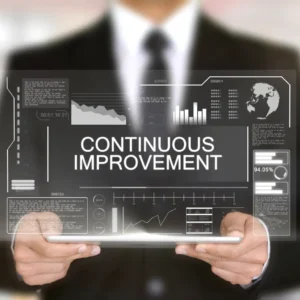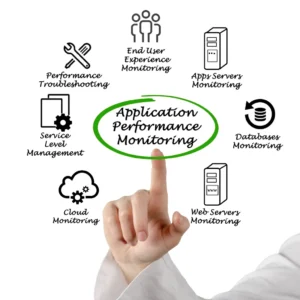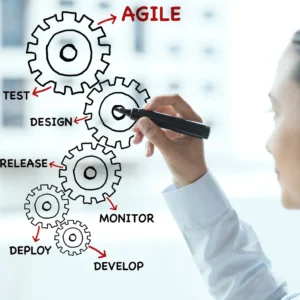
Strategic Implementation of Intelligent Process Automation
Continuous Improvement Strategies and Protocols for Enhanced Automation Processes
Welcome to our exploration of “Strategic Implementation of Intelligent Process Automation: Continuous Improvement Strategies and Protocols.” In the rapidly evolving automation landscape, organizations are navigating the intricate realm of Intelligent Process Automation (IPA).
This article explores essential ideas related to continuous improvement strategies and protocols. We emphasize the importance of strategic implementation to maximize the benefits of IPA fully. By implementing a solid strategy, we can ensure that IPA is used effectively and efficiently.
From establishing governance frameworks to fostering a culture of innovation, our discussion revolves around achieving a harmonious balance between automation and human oversight. We unravel innovative approaches to drive efficiency gains, adapt to changing business needs, and ensure ethical and transparent practices.
Join us on a journey through dynamic strategies, proactive measures, and user-centric design principles, emphasizing the user experience in continuously improving automation processes. Learn how these adaptive protocols, aligned with compliance standards, contribute to the success of IPA implementation and organizational growth.
Table of Contents

Arindam Roy
An Automation Consultant with 25+ years of IT Experience
Change Readiness Assessment
Implementing Intelligent Process Automation (IPA) requires a thorough Change Readiness Assessment to ensure a smooth transition. Strategic Implementation involves defining Protocols for Evaluating Organizational Readiness for Automation-Driven Transformations.
This includes innovative approaches for assessing Cultural and Technological Preparedness, striking a delicate balance between Automation and Human Oversight.
Dynamic Strategies are pivotal in identifying Organizational Challenges and Opportunities during change. Governance Frameworks ensure ethical and transparent assessment practices, aligning with Proactive Measures to meet Business Objectives. Adaptive Readiness Assessment Protocols cater to varied Organizational Structures and Environments, acknowledging the unique needs of each context.
User-centric design Principles guide the development of assessments, optimizing the User Experience in readiness evaluations. Compliance with Change Management Standards and Best Practices is vital to uphold quality and efficiency in IPA implementation.
A comprehensive approach to Change Readiness Assessment ensures successful automation adoption and fosters a culture of adaptability and continuous improvement within the organization.
Stakeholder Engagement and Communication
Implementing Intelligent Process Automation (IPA) necessitates a thoughtful approach to Stakeholder Engagement and Communication. A Strategic Implementation involves developing Protocols for Effective Communication Plans that address the unique challenges of automation transformation. Innovative Approaches to Engaging and Informing Stakeholders ensure a comprehensive understanding of the change process.
To strike a balance between Automation and Human Oversight, robust Stakeholder Communication Strategies are crucial. Dynamic Protocols for addressing concerns and managing expectations provide a flexible framework for adapting to evolving circumstances.
Governance Frameworks ensure Ethical and Transparent Stakeholder Communication Practices, aligning with Proactive Measures to gain Stakeholder Buy-In and foster support for automation initiatives.
Adaptive Communication Strategies, tailored to Varied Stakeholder Groups and Perspectives, acknowledge an organization’s diverse needs and concerns. User-centric design Principles optimize the User Experience in Stakeholder Communication, enhancing clarity and engagement.
Lastly, Compliance with Communication Regulations and Standards is imperative in IPA Implementation, ensuring that communication aligns with legal and ethical guidelines. A holistic approach to Stakeholder Engagement and Communication is integral to the success of Intelligent Process Automation initiatives.
Training and Upskilling Programs
In the realm of Intelligent Process Automation (IPA), a Strategic Implementation of Training and Upskilling Programs is essential to equip employees for the evolving landscape.
Protocols for Designing Comprehensive Training Initiatives cater to employees affected by automation, fostering their adaptation to new roles and responsibilities. Innovative Approaches to Upskilling Personnel involve dynamic strategies that balance Automation and Human Oversight through robust employee development programs.
To stay aligned with rapidly evolving automation technologies, Dynamic Strategies adapts Training Programs accordingly. Governance Frameworks guide the ethical and transparent implementation of training initiatives, ensuring compliance with ethical standards. Proactive Measures address skill gaps and enhance workforce competencies in automation, creating a skilled and adaptable workforce.
Adaptive Training Protocols, tailored to Varied Employee Roles and Automation Scenarios, acknowledge the diverse needs within the organization. User-centric design Principles optimize the User Experience in Training and Upskilling Programs, enhancing engagement and effectiveness.
Compliance with Training Standards and Regulations is paramount in IPA Implementation, ensuring training programs adhere to legal and ethical guidelines. A holistic approach to Training and Upskilling Programs is pivotal in fostering a workforce that can thrive in the age of automation.
Impact Analysis and Risk Management
In implementing Intelligent Process Automation (IPA), a Strategic Implementation of Impact Analysis and Risk Management is crucial to navigate changes effectively.
Protocols for Conducting Thorough Impact Analysis on Business Processes and Personnel ensure a comprehensive understanding of the implications of automation. Innovative Approaches to Identifying and Mitigating Risks associated with automation-driven changes involve a proactive stance in managing potential challenges.
Balancing Automation and Human Oversight requires Comprehensive Risk Management Strategies, integrating technical and human factors. Dynamic Impact Assessment Strategies continually evaluate the effects of automation on operations, allowing for timely adjustments. Governance Frameworks guide Ethical and Transparent Impact Analysis and Risk Mitigation, ensuring adherence to ethical standards.
Proactive Measures play a pivotal role in anticipating and managing unintended consequences of automation, fostering a resilient system. Adaptive Risk Management Protocols are tailored to Varied Business Processes and Automation Scenarios, recognizing the diversity of organizational contexts. User-centric design Principles optimize the User Experience in Risk Management Processes, enhancing clarity and usability.
Compliance with Impact Analysis and Risk Management Standards is vital in IPA Implementation, ensuring that practices align with established guidelines. A holistic approach to Impact Analysis and Risk Management safeguards organizations, enabling them to address challenges associated with automation proactively.
Governance Frameworks for Change
In the Intelligent Process Automation (IPA) landscape, a Strategic Implementation of Governance Frameworks for Change is imperative for successful and ethical transformations. Protocols for Establishing Effective Governance Structures lay the foundation for overseeing automation-driven transformations, ensuring that changes align with organizational objectives.
Innovative Approaches to Ethical and Transparent Implementation of Change Governance in IPA involve integrating ethical considerations into decision-making processes, fostering transparency and accountability. Balancing Automation and Human Oversight necessitates Robust Governance Frameworks, ensuring a harmonious integration of technology and human elements. Dynamic Governance Protocols adapt to Evolving Business Needs and Technological Advancements, providing flexibility in response to changes.
Proactive Measures align Governance with Organizational Values and Goals, creating a synergy between governance practices and the organization’s broader mission. Adaptive Governance Strategies, tailored to Varied Change Initiatives and Business Environments, acknowledge the diverse nature of transformation projects. User-centric design Principles optimize the User Experience in Governance Processes, enhancing accessibility and usability.
Ensuring Compliance with Governance Standards and Best Practices is crucial in IPA Implementation, upholding quality and ethical standards. Collaborative Platforms and Tools facilitate implementing and managing Effective Governance Frameworks, fostering stakeholder communication and coordination.
A comprehensive approach to Governance in Intelligent Process Automation ensures successful implementation and contributes to a responsible and transparent change management culture.
Human-Centric Design Principles
The Strategic Implementation of Human-Centric Design Principles in Intelligent Process Automation (IPA) ensures that automated processes prioritize and enhance the user experience. Protocols for Prioritizing User Experience and Human Interaction in Automation Workflows lay the foundation for designing workflows that align with user needs and preferences.
Innovative Approaches to Designing Automation Processes involve a focused commitment to user-centricity, emphasizing creating intuitive, user-friendly solutions. Balancing Automation and Human Oversight requires Cohesive Human-Centric Design Strategies, ensuring a seamless technology integration while considering the human element in the process.
Dynamic Design Principles adapt to evolving user expectations, optimizing User Interaction and Engagement in Automation. Governance Frameworks guide the Ethical and Transparent Implementation of Human-Centric Design in IPA, ensuring user-centricity aligns with ethical standards. Proactive Measures involve consistently aligning Automation Workflows with User Needs and Preferences, fostering user satisfaction and efficiency.
Adaptive Design Protocols, tailored to Varied User Groups and Automation Scenarios, acknowledge the diversity of users and contexts. Ensuring Compliance with User-Centric Design Standards and Best Practices is crucial to maintaining high-quality user experiences.
Collaborative Platforms and Tools facilitate the Implementation and Management of Effective Human-Centric Design Principles, enabling stakeholder communication and coordination. When designing automated processes, it’s essential to prioritize the user experience. A holistic approach to Human-Centric Design can help achieve this goal and contribute to the initiative’s overall success.
This means considering the needs of the people who will be using the automated processes and designing them in a way that is easy to use and understand. By doing so, we can ensure that Intelligent Process Automation is effective and efficient and that users can get the most out of it.
Continuous Feedback Mechanisms
The Strategic Implementation of Continuous Feedback Mechanisms is integral to the success of Intelligent Process Automation (IPA) initiatives, ensuring a responsive and user-centric approach. Protocols for Establishing Effective Channels for Continuous Feedback from Users and Stakeholders set the stage for open communication and engagement.
Innovative Approaches to Capturing and Analyzing User Feedback for Automation Improvement involve leveraging technology to systematically gather and assess user insights. Balancing Automation and Human Oversight necessitates Robust Continuous Feedback Strategies, where technological and human elements contribute to refining processes.
Dynamic Mechanisms for Adapting Automation Processes Based on Continuous User Input enable real-time adjustments, keeping automation aligned with evolving user needs. Governance Frameworks guide the Ethical and Transparent Implementation of Feedback Systems in IPA, ensuring that feedback practices adhere to ethical standards.
Proactive Measures foster a Culture of Open Communication and Feedback in Automation, encouraging employees to share their perspectives. Adaptive Feedback Protocols, tailored to Varied User Groups, Processes, and Automation Scenarios, acknowledge the diversity within the organization. User-centric design Principles optimize the User Experience through Continuous Feedback, creating a cycle of improvement.
It is crucial to adhere to feedback standards and best practices to ensure the quality and integrity of IPA implementation. This ensures compliance and helps to improve the feedback process. Continuous feedback mechanisms enhance user satisfaction and contribute to the agility and adaptability of automation processes.
Cultural Transformation Initiatives
The Strategic Implementation of Cultural Transformation Initiatives is pivotal for successfully integrating Intelligent Process Automation (IPA) into an organization. Protocols for Fostering a Culture that Embraces Automation and Innovation provide the groundwork for a mindset shift toward automation.
Innovative Approaches to Cultural Change focus on aligning organizational values with the goals of IPA Implementation, creating a cohesive and purpose-driven environment. Balancing Automation and Human Oversight requires Effective Cultural Transformation Strategies, ensuring that automation complements human efforts seamlessly.
Dynamic Measures for Aligning Organizational Values with Automation Objectives involve continual assessment and adjustment to maintain alignment as goals evolve. Governance Frameworks guide the Ethical and Transparent Implementation of Cultural Change in IPA, ensuring that the cultural shift adheres to ethical standards.
Proactive Cultural Transformation Initiatives nurture a Positive Attitude Toward Automation, encouraging employees to embrace change. Adaptive Strategies for Involving Employees in the Cultural Shift Toward Automation recognize the importance of employee engagement in the transformation process.
User-centric design Principles optimize the User Experience in a Transformed Culture, considering the impact of cultural change on individuals. Ensuring compliance with cultural change standards and regulations is essential to maintaining a structured and ethical approach to cultural transformation in the context of IPA implementation.
A holistic approach to cultural transformation facilitates the acceptance of automation and contributes to the organization’s overall success in the digital era.
Change Metrics and Key Performance Indicators (KPIs)
The Strategic Implementation of Change Metrics and Key Performance Indicators (KPIs) in Intelligent Process Automation (IPA) is essential for quantifying the success and impact of automation-driven changes. Protocols for Defining and Measuring the Success and Impact of Automation-Driven Changes provide a structured framework for assessment.
Innovative Approaches to Establishing Meaningful Metrics and KPIs for Change Initiatives involve tailoring indicators to reflect the specific goals and objectives of automation implementation. Balancing Automation and Human Oversight requires Robust Performance Measurement Strategies, considering both quantitative and qualitative factors in the assessment.
Dynamic Metrics for Monitoring and Reporting on the Effectiveness of Change Initiatives enable real-time insights and adjustments as needed. Governance Frameworks guide the Ethical and Transparent Metric and KPI Implementation in IPA, ensuring that measurement practices align with ethical standards.
Proactive Measures for Aligning Metrics and KPIs with Business Objectives in Automation involve a strategic alignment between measurement criteria and overall organizational goals. Adaptive Measurement Protocols, tailored to Varied Change Initiatives and Business Environments, recognize the diversity of transformation projects.
User-centric design Principles optimize the User Experience in Metric and KPI Dashboards, ensuring clarity and usability. Ensuring Compliance with Metric and KPI Standards and Best Practices is crucial to maintaining the accuracy and reliability of performance measurements in the context of IPA Implementation. A comprehensive approach to change metrics and KPIs quantifies success and informs ongoing improvements in the automation journey.
Continuous Improvement Strategies
The Strategic Implementation of Continuous Improvement Strategies is crucial for the ongoing success of Intelligent Process Automation (IPA). Protocols for Establishing an Ongoing Framework for Enhancing Automation Processes create a structured approach to iterative enhancements.
Innovative Approaches to Identifying and Implementing Efficiency Gains in Automation Workflows involve leveraging technology and user insights to drive improvements. Balancing Automation and Human Oversight requires Robust Continuous Improvement Initiatives, ensuring that technical and human aspects contribute to optimizing processes.
Dynamic Strategies for Adapting to Changing Business Needs and Technology Advancements acknowledge the need for flexibility and agility in response to evolving circumstances. Governance Frameworks guide the Ethical and Transparent Implementation of Continuous Improvement in IPA, ensuring that improvement initiatives align with ethical standards.
Proactive Measures for Iterative Enhancement of Automation Processes Based on User Feedback involve a responsive approach to user needs and preferences. Adaptive Improvement Protocols, tailored to Varied Automation Scenarios and Business Environments, recognize the diversity of automation applications.
User-centric design Principles optimize the User Experience in Continuous Improvement, ensuring that enhancements contribute positively to the user journey. Ensuring Compliance with Continuous Improvement Standards and Best Practices is vital to maintaining the quality and reliability of enhancements in the context of IPA Implementation.
A comprehensive approach to continuous improvement fosters efficiency gains and creates a culture of adaptability and innovation within the organization.
Conclusion
In conclusion, the Strategic Implementation of Intelligent Process Automation (IPA) demands a holistic approach, encapsulating continuous improvement strategies and robust protocols.
Through the lens of this exploration, we’ve unveiled the pivotal role of governance frameworks, dynamic strategies, and user-centric design principles in achieving a harmonious balance between automation and human oversight.
As organizations embrace change, IPA’s ethical and transparent implementation becomes paramount. From fostering a culture that embraces innovation to aligning metrics and KPIs with business objectives, every aspect contributes to the overarching success of automation initiatives. The iterative enhancement of processes based on user feedback reinforces a commitment to user experience, optimizing efficiency and satisfaction.
This journey through continuous improvement in IPA underscores the importance of strategic planning, adaptability, and user-centricity. By adhering to compliance standards and best practices, organizations can confidently navigate the complexities of automation, fostering a culture of innovation and resilience for sustained success in the ever-evolving digital landscape.
Related Articles
- Choosing the Right Automation Tool in 7 Steps
- A 9-Step Guide to IPA Implementation: Energise Your Operations
- Navigating the Roadblocks of IPA – The Top 9 Challenges
- AI in Intelligent Process Automation – Unleash the Power of AI
- 9 IPA Examples in Small-Scale Industries
- Power of Intelligent Business Process Automation – Efficiency
- AI Business Process Management: Unleashing the Power
- Business Process Management with AI Integration
- AI for Reengineering Business Processes
- Hyperautomation: Redefining BPM with AI
- The Role of AI in Business Process Modelling
- AI-driven Customer Onboarding – Unleash the Power of AI
- Effective Process mapping in Intelligent Process Automation
- Intelligent Process Automation Adoption – The Best Strategy Guide
- TechInfra in IPA: A Comprehensive Guide
- Elevating Intelligent Automation with Continuous Improvement
- Comprehensive Approach to Cost-Benefit Analysis in IPA
- Vendor Selection in IPA – Comprehensive Guide
- Implementing Agile in Intelligent Process Automation (IPA)
- Scalability and Integration in Intelligent Process Automation
- Cognitive Automation in IPA: Innovating Ethical Efficiency
- Mastering Symphony: Bot Development in IPA Unveiled
- UI/UX Mastery in IPA: Elevating Automation Experiences
- Compliance and Security in IPA – A Guide Ensuring Trust
- Impact of Performance Monitoring and Analytics in IPA
- Driving Success: Data Management in IPA
- Crucial Role: Documentation in IPA Triumph
- Optimizing IPA – Continuous Improvement Strategies
































